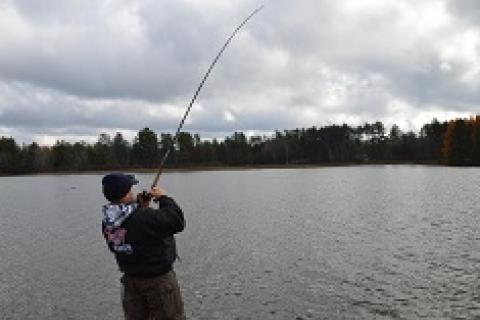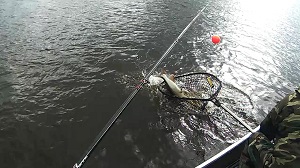
Muskie anglers are an odd group. The tougher the weather, stronger the winds, and harder the rains- in short, the more brutal the conditions-the more they are happy. Not that the fish necessarily hit better under those conditions, in fact at times much to the contrary; it's more the challenge of the 'hunt' directly proportional to the unpleasant to even brutal weather conditions. Very odd group indeed.
The late fall is a special time for muskie crazies like MuskieFIRST.com's Keith Worrall. As the water temps fall into the 40's, the truly big muskies pack on the weight and as muskie folks like to say, 'put on the feedbag'. Freezing air temperatures, skim ice, snow, sleet, and cold North winds? Perfect! In the states where Muskie season closes, the close usually coincides with ice up, so the month of November across the Northern Range is the last hurrah until the opener in the spring. This is when quick strike rigs, rod holders, and live suckers come into play for a number of reasons. 
To clarify, suckers will catch muskies all year long. Problem is, they are very difficult to keep alive in warm conditions, and as a result, bait dealers won't carry them and muskie anglers are reluctant to buy them at as much as $10 a sucker only to have the sucker die early in the day. Once the temps hit the low 50's, the livewell water and lake temps are cool enough for good survival rates for a rigged sucker and the investment can pay off big time.
Gear.
The rod chosen is usually a graphite composite blank or glass trolling rod in 7' to 8.5', as the hook set is as hard as any in the sport, and temperatures sometimes brutally cold. A casting reel with a clicker is very important to alert the angler a muskie has taken the bait. Line is in the 80# class of superlines or heavier, to eliminate breakoffs on the hook set. MuskieFIRST.com's Keith Worrall prefers to use his Abu reels matched with a St. Croix rod spooled with 80# line. "I like a heavy action rod, with enough flex so I don't break off the quick strike rig, while offering a strong, punch 'em in the face hookset", Keith says. "The reel has the drag tightened all the way down. No give beyond the drag capacity. I need to cross that muskie's eyes on the hookset or the trebles won't penetrate the muskies hard, toothy mouth."
"The quick strike rig is critical to successful release of the muskies caught using this technique", Keith explains. Serious muskie anglers follow a strict Catch, Photo, Release philosophy, and as a result, muskie angling has never been better across the range. “We used to use single J hooks on a heavy wire leader, and let the fish have them for a long period of time. These are appropriately called 'swallow kill rigs' and should be banned from the shelves. If a muskie swallows the hook, it's dead. A Wisconsin DNR study a few years ago proved this to be absolute fact. Use a quick strike rig, hit the fish fast, or don't use live bait for muskies!" 
There are a number of rigs available, as are the materials to make your own. A heavy braided wire leader tied or crimped to as few as one and as many as three hooks and high quality hardware all the way around makes up the best rigs. Once rigged up, the sucker can swim freely, and when a muskie blasts it, the hooks will be where they need to be to set the hook right away breaking free of the sucker, so hook ups will be in the mouth and usually easy to remove. A good pair of long nose pliers, a set of hook cutters, and a high quality jaw spreader are required. If it's tough to get the rig removed, cut the hooks, remove the rig, and then remove the rest of the hook. This procedure is usually accomplished while the fish is in the net and in the water.
“You are going to have cold hands when the release is completed, but it's worth it!" Keith says.
Techniques
Some prefer to float the rig along on a bobber set at the correct depth above the sucker to keep it out of the weeds and other obstructions, placing the rod in a rod holder and pulling the rig along (where legal) very slowly while casting an artificial. Others prefer no bobber. Drop the sucker over the side, set the depth, set the reel clicker, and start casting with your other outfit, listening for the clicker to start buzzing. Set the cast control on the reel so the sucker can't take line, and keep the reel on free spool so when a muskie takes the bait, it can move away without feeling pressure allowing the angler to get the rod out of the holder and set the hook. Sucker sizes are a matter of choice; most bait shops sell small, medium, and large, running 12" to as much as 20". There's no real indication that bigger suckers catch bigger muskies, and it's a constant debate which are more effective. “I like the mediums." Keith says, "They are less money than the big ones, the muskies eat them just fine, and most importantly, the muskies get the mediums into their mouth easier and I get better hookups without a potential swallow mishap the small suckers are famous for."
Watch your sonar!
As you move across structure and break lines, especially if you are also casting, muskies will follow up the lure, and if the fish turns off the artificial and sees the sucker, it will zero in on that sucker quickly. Your sonar will clearly display a heavy dark line for a muskie that's staying with the sucker following it, and a hook if the fish swims through the sonar signal cone. It's a cool experience to see the fish on the sonar, and watch it come up to and take the sucker. "I had one this weekend create a beautiful mark on my Humminbird, and actually told my buddies in the boat there was a muskie under us. As we drifted over the fish, she saw the sucker, seconds later ate it, and the battle was on!"
"I cast over to where I thought the muskie might be and burned a bucktail over her head. I think she followed it but turned off and blasted the sucker. When the muskie took the sucker, the bobber hopped a couple times and disappeared. I grabbed the rod, set the hook, and played a nice 42" Wisconsin Muskie into the Frabill. It was cold, windy, and mean out there, but none of us noticed!"
If you have never tried using suckers for muskies, give it a whirl this fall. It can extend your season a few days as the guides freeze in your casting outfits, and can make for some exciting and rewarding time on the water.
Remember...catch, photo, and release. The future of muskie fishing is in your hands! Statistics show in some trophy muskie waters, many of the adult fish have been caught and released several times. CPR!
- 10495 views

